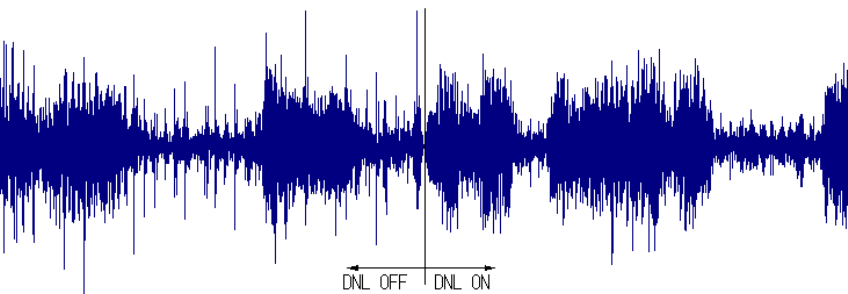
23
First, the input signal is divided into its low- and high-frequency components. Ignition and other
pulse noise tends to be concentrated in the latter, from which amplitude variation is output. The
attenuation coefficient derived from this signal is multiplied by the input signal. As soon as pulse
noise occurs, the attenuation coefficient rises instantaneously, thus damping the amplitude
variation in the input signal. Because of this adaptive processing performed by the DNL and based
on the amplitude variation, the output signal has virtually none of the “digital feel” that is often the
mark of digital signal processing. It is perhaps only natural to associate this DNL with the old “noise
limiter” technology, but as explained it works on a completely different principle, performing the sort
of advanced processing that is only possible with DSP.
Because the TS-480 will be often used for mobile operations, DNL parameters have been tuned
so as to have maximum effect on ignition noise. However, even when used as a fixed station, it
can be very effective on irregular, unanticipated noise, so we recommend that you try making use
of it, in combination with the noise blanker as well.
Fig.14 demonstrates how ignition noise is reduced by the DNL.
Fig. 14: The effect of DNL on ignition noise
The DNL works in SSB, CW, FSK and AM modes, and it can be used in conjunction with other
interference reduction and noise elimination features.
●
Noise reduction
There are two methods available for noise reduction: NR1 and NR2. NR1 is a line enhancer that
employs adaptive filter technology. By shaping a filter that lets through signals with a certain
amount of periodicity, as with voice and CW, it can suppress noise that falls outside the passband.
NR2 employs what is known as SPAC (speech processing by auto correlation) technology. What
results from looping one cycle of the RX signal’s autocorrelation coefficient is then output as the
received audio. What this means is that only periodic signals found in the received audio emerge.
In principle this approach can result in a small amount of noise at the “seam” where the periodic
signal is looped together, but in practice it proves extremely effective at noise compression.
NR1 is a good choice for SSB and other audio signals, while NR2 is especially effective when
used with single frequencies, as with a CW signal.
Figs. 15~17 demonstrate the effect of applying NR1 and NR2. For comparison purposes, the
same weak sine signal was received, with the audio output monitored by an FFT analyzer.


















